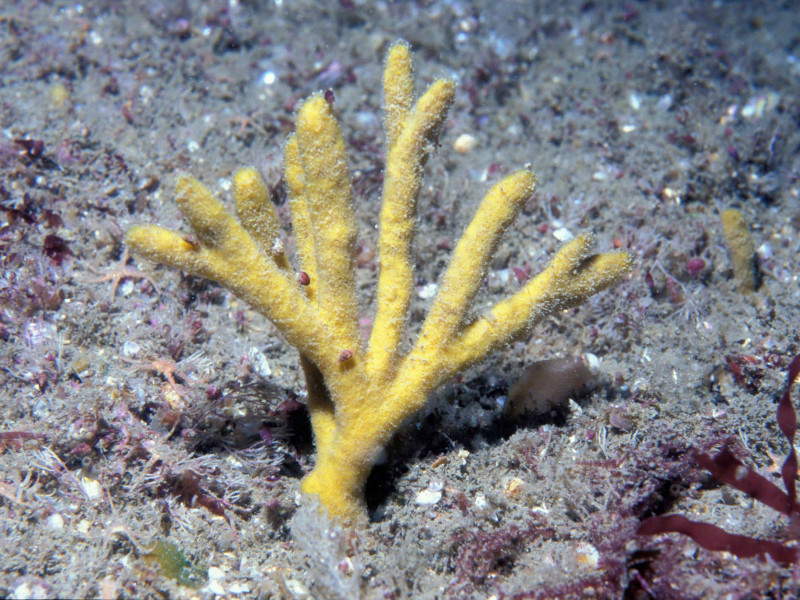A branching sponge (Raspailia (Clathriodendron) hispida)
Distribution data supplied by the Ocean Biodiversity Information System (OBIS). To interrogate UK data visit the NBN Atlas.Map Help
| Researched by | Megan Maleed | Refereed by | This information is not refereed |
| Authority | (Montagu, 1814) | ||
| Other common names | - | Synonyms | Spongia hispida (Montagu, 1814), Axinella hispida (Montagu, 1814), Dictyocylindrus hispidus (Montagu, 1814) |
Summary
Description
A tall mustard yellow to pale brown branching sponge reaching up to 35 cm in length with thin hairy branches of up to 13 cm in length. Branches may taper to points. It si found commonly in the deep sublittoral alongside other branching sponges. Typically, one to three stalks branch from the base but some may have branches that arise immediately from the basal stalk. The sponge surface is hairy or bristled (hispid) because spicules protrude from its surface. These spicules can trap a layer of silt and give the sponge a ‘dirty’ appearance. Small exhalent apertures (oscules) are visible underwater and tend to form evenly spaced rows along the edges of branches, but they are not visible when preserved. This species does not produce slime when taken out of the water.
Recorded distribution in Britain and Ireland
Raspailia hispida is widespread on the rocky coasts of western Britain, in the English Channel, Northern Ireland and the Irish Sea, with sparse records on the east coast of Scotland in the Shetland Islands and the Firth of Forth.
Global distribution
Raspailia hispida is widespread across rocky coastlines in south and west Britain, with scattered records from Norway, the North Atlantic and the Mediterranean.
Habitat
Regularly found on horizontal and vertical rocky bedrock, or boulders, in moderately exposed coastal areas or in sheltered areas with some tidal movement. Often found alongside other Axinellid sponges.
Depth range
0-300 mIdentifying features
- Yellow to brown branching sponge
- Up to 35 cm high, with branches up to 13 cm in length
- 4 to 6 mm branches that taper to blunt tips
Additional information
This species can only be definitively identified through microscopic examination. In the field, it can be confused with similar species such as Stelligera stuposa but is typically taller and less branched (Bowen et al., 2018). Stelligera stuposa also produces slime when removed from the water which Raspailia hispida does not.
Listed by
- none -
Bibliography
Ackers, R.G.A., Moss, D. & Picton, B.E. 1992. Sponges of the British Isles (Sponges: V): a colour guide and working document. Ross-on-Wye: Marine Conservation Society.
Bowen. S., Goodwin. C., Kipling. D. & Picton. B., 2018. Sea Squirts and Sponges of Britain and Ireland, Seasearch Guide. Plymouth: Wild Nature Press.
Hayward, P.J. & Ryland, J.S. (ed.) 2017. Handbook of the marine fauna of North-West Europe. Oxford: Oxford University Press.
Picton, B.E. & Morrow C.C., 2005. Encyclopedia of Marine Life of Britain and Ireland http://www.habitas.org.uk/marinelife/species.asp?item=D10920, 2008-01-08
Picton, B.E., Morrow, C.C. & van Soest, R.W.B., 2007. [In] Sponges of Britain and Ireland: http://www.habitas.org.uk/marinelife/sponge_guide/sponges.asp?item=C2134
Van Soest, R.W.M., Picton, B. & Morrow, C., 2024. Sponges of the North East Atlantic, 2.0. Leiden, Netherlands: Linnaeus NG - Naturalis Biodiversity Center. Accessed [2024-10-04]. Available from https://sponges-ne-atlantic.linnaeus.naturalis.nl/linnaeus_ng/app/views/introduction/topic.php?id=3392&epi=168
Datasets
Manx Biological Recording Partnership, 2022. Isle of Man historical wildlife records 1990 to 1994. Occurrence dataset:https://doi.org/10.15468/aru16v accessed via GBIF.org on 2024-09-27.
NBN (National Biodiversity Network) Atlas. Available from: https://www.nbnatlas.org.
OBIS (Ocean Biodiversity Information System), 2025. Global map of species distribution using gridded data. Available from: Ocean Biogeographic Information System. www.iobis.org. Accessed: 2025-08-08
South East Wales Biodiversity Records Centre, 2023. SEWBReC Marine and other Aquatic Invertebrates (South East Wales). Occurrence dataset:https://doi.org/10.15468/zxy1n6 accessed via GBIF.org on 2024-09-27.
Citation
This review can be cited as:
Last Updated: 27/09/2024



